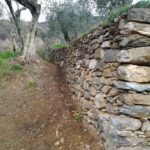 The slopes of Monte Pisano in general, and of the Park in particular, are characterized by embankments that follow one another down the slope, forming terraced systems.
The slopes of Monte Pisano in general, and of the Park in particular, are characterized by embankments that follow one another down the slope, forming terraced systems.
The terraced system consists of three fundamental elements that together contribute to making the steep slopes of the Monte cultivable and regulating water runoff (drainage network):
- “Lenza” (terrace or platform) – a horizontal element where cultivation takes place.
- “Argine” (embankment) – a vertical element designed to contain the embankment, generally constituted by a dry stone wall.
- “Canaletta di sottoscarpa” (sub-slope channel) – a trench placed at the base of the embankment, necessary for transporting water downhill from the slopes.

Ancient pathways also form part of the drainage network of Monte, which functioned as collectors for water coming from the sub-slope channels and guard ditches, which are the channels responsible for the initial interception of rainwater at the upper part of the Monte, the forested area.
The September 2018 fire compromised the drainage network and erased the anchoring effect that tree roots have on the soil. It was therefore essential to restore the drainage network, rebuild the dry stone walls, and perform regular maintenance. Neglected dry stone walls tend to bulge and eventually collapse, and if the channels are not periodically cleaned, they tend to clog. For these reasons, the Agroecology Office of Calci organizes Dry Stone Wall Schools during which it is possible to observe and participate in the construction of a dry stone wall and the restoration of sub-slope channels.
HOW IS A DRY STONE WALL BUILT?
The construction of a dry stone wall begins with preparing the “lenza”: its downhill edge is split off, giving it an incline of about 30° uphill. This provides the lenza with a slope that allows it to more easily accommodate stones and better withstand the downhill pressure of the embankment. To prevent landslides, the entire lenza has an incline uphill. Next, stones that will constitute the wall are selected. Generally, those available at the construction site are used (often removed from the lenza itself), ensuring a local construction approach, and are carefully chosen by the “Mastro Muraiolo,” the artisan specialized in wall construction. The Mastro Muraiolo selects each stone so that it fits perfectly with those below it, giving stability to the wall. Smaller stones are placed at the back of the wall to facilitate water drainage into the soil. The dry stone wall is designed to channel excess water downhill from the lenza into the sub-slope channels. Therefore, the use of cement is strongly discouraged, as it would make the wall nearly impermeable. Finally, the sub-slope channel is dug, a trench placed at the base of the wall and parallel to it, where drained water flows.
Photo by Marco Tito Fortunati taken as part of the project Arci Migranti: Dry Stone Walls.
On Monte Pisano, there are also half-moon-shaped terraces, known as “lunettamenti” or “lunette” (photo by Maurizio Bertolini). These are typically dedicated to tree crops such as olives and chestnuts and are constructed where the terrain has slopes greater than 45°, where other types of terracing could not be built. In this way, land that would otherwise remain unproductive becomes cultivable. The lunettes are also present in the Park, but here they were created not so much due to the slope, but rather to create a connection between one rocky outcrop and another.

The uniqueness of the art of building dry stone walls is so important that it was included in the UNESCO intangible cultural heritage list on December 1, 2018, with the following justification: “These constructions demonstrate the harmonious relationship between humans and nature and, at the same time, play a vital role in preventing landslides, floods, and avalanches, as well as combating soil erosion and desertification.”
Bibliography:
M. Galli, D. Rizzo & F. Casella (2008) “Il paesaggio terrazzato del Monte Pisano
tra permanenza e mutamenti” ETS, Pisa.
D. Rizzo, F. Casella, M. Galli & E. Bonani (2009) “La gestione delle sistemazioni idraulico-agrarie nel Monte Pisano: schede descrittive e operative” Land Lab, Scuola Superiore di Sant’Anna Pisa e Comune di Calci.



